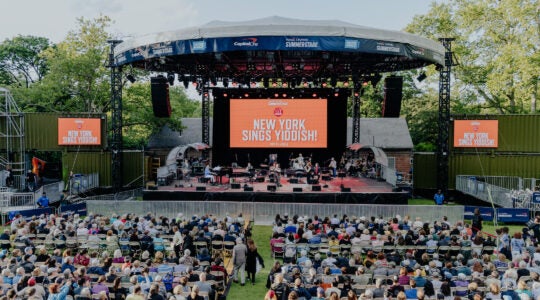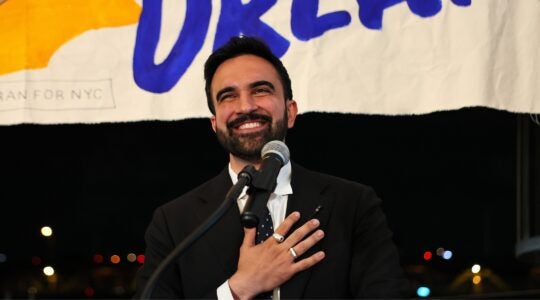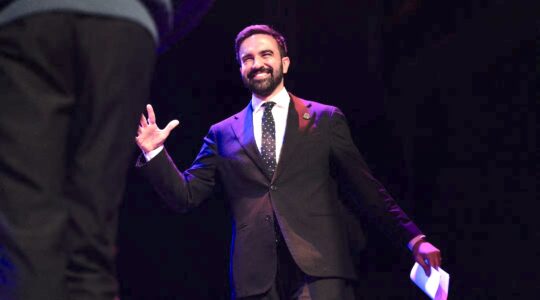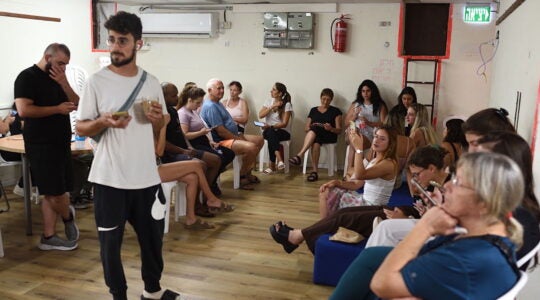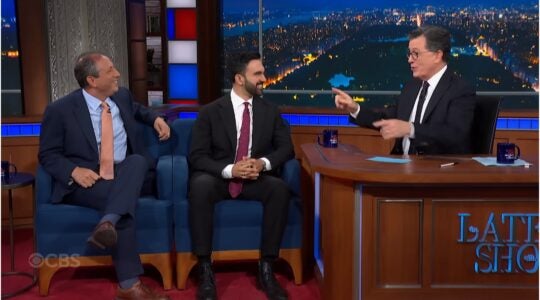Hometown Synagogues Reaching Out To Students
What do hamantaschen, a Starbucks gift card and a pharaoh punching bag have in common?
They’re all goodies that Jewish college students may find in care packages sent by their hometown synagogues.
Synagogues across denominations keep in touch with college students in a variety of ways, from sending holiday food packages and putting the students on the newsletter mailing list, to inviting them to participate on Facebook pages and having the rabbi visit campus to take them out for dinner.
The Union for Reform Judaism, the United Synagogue for Conservative Judaism, and the Orthodox Union all encourage such connections, with many synagogues requiring only that parents supply a campus address but others charging parents a fee.
At the Greenburgh Hebrew Center in Dobbs Ferry, N.Y., students receive care packages for Rosh HaShanah, Chanukah, Purim and Passover. The packages typically consist of kosher holiday-related foods, but freshman can also expect an electric menorah for Chanukah, while older students might get a mug or glass dreidel. Plus, they’ll get the occasional email from their rabbi, as well as information about Birthright Israel, the program that sends young adults ages 18-26 to Israel at no cost.
“I get wonderful, wonderful little thank you notes,” says Naomi Feinkind, who has chaired Greenburgh’s Koach outreach program for the past decade.
“I get kids that are in their late 20s who say, ‘I still have that menorah,’” she says.
Feinkind recounts the time a student told her that he and his roommate, who was also Jewish, had been thinking about getting a Christmas tree their freshman year — until the Chanukah package showed up. “They scuttled the tree,” she says.
At Adat Shalom in Farmington, Mich., Jodi Gross has been working on college outreach since 2006. “When students go away to college, I think they’re in that part of their lives where they’re looking for something,” she says. “It’s important that they know that the rabbi, the cantor and myself, as education director, are there for them if they need help.”
Adat Shalom students receive a Starbucks gift card for Hanukkah, along with a letter from the rabbi or cantor, and a food package for Passover. “We send the junk food,” she says, “usually the kinds of things that you can’t find near campus,” along with information on how to make a kitchen kosher for Passover.
She also maintains a Facebook page geared to the students and invites students coming home for the High Holy Days to help lead youth services so that they remain connected to the synagogue. And, with 80-90 percent of Adat’s students attending schools in state, one of the clergy tries to visit each campus at least once a semester.
Josh Maroff, who’s entering his second year at Michigan State University, doesn’t think the Facebook page is much help. “It’s not like a conversational page,” he says. Overall, he calls the outreach, particularly the campus visit, “a nice way to remind you there are people at home who care about you, to remind you about the importance of Judaism.”
His freshman year he was one of about 15 students — half from his class — to attend a dinner with Rabbi Aaron Bergman. It was really nice, Maroff, 18, says, “to have the Jewish conversations we had in Hebrew school that we hadn’t had in a while.”
For his part, Rabbi Bergman says, “I’m just there to hang out.”
“Let’s have some food together and hang — just to see what’s on their mind and what they’re thinking, who looks happy and who looks not so happy,” he says.
Staying in touch is part of maintaining continuity, officials say. “Hopefully they’ll remember us in the future or remember that a synagogue cared about them,” Rabbi Bergman says. “I just want them to have a good thought about the Jewish community.”
When Ari Paskoff joined Temple Rodef Shalom in Falls Church, Va., as youth director a couple of years ago, he thought that gifts such as an Egyptian pharaoh punching bag or matzah-decorated juggling balls might be a little cheesy. But he found that students get a kick out of them.
Plus, he says, the holiday packages, which also typically included holiday-related foods, make an impact on the congregation’s younger students.
“When I’m packing the stuff, the youth groups I work with will see what we’re doing and say, ‘I can’t wait till I get that in college,’” Paskoff says.
Debra Rubin/JNS.org
Teachers To Get ‘Blended-Learning’ Instruction
Bar-Ilan University’s Lookstein Center will be training 16 New York-area day school teachers in how to run a “flipped classroom” this fall.
Funded by UJA-Federation of New York, the nine-month course is one of a handful of new programs helping Jewish day school teachers incorporate high-tech strategies into their work.
In a “flipped classroom,” teachers replace classroom lectures with online ones students view from home, using school hours instead for working individually and in small groups with students to help them process the material. The technique is one strategy of “blended learning,” combining online studies with face-to-face ones.
In addition to the Lookstein course, Yeshiva University’s Institute for University-School Partnership runs a certificate program in “online/blended instruction and design,” and several foundations are teaming up on BOLD (Blended Online Learning) Day Schools, a program to help established day schools implement blended learning.
Among the schools participating in the “flipped classroom” training are SAR High School in Riverdale, Ramaz Middle School in Manhattan, Solomon Schechter of Westchester High School, Magen David Yeshivah in Brooklyn; Yeshivah of Flatbush Elementary School in Brooklyn, and Shulamith Middle School in Cedarhurst, L.I.
Believed to reduce costs and be more engaging for students, blended learning has become increasingly popular in secular and Jewish education. In the past two years, several new Jewish day schools employing this model have launched — including Westchester Torah Academy in New Rochelle, which is slated to open this fall.
Julie Wiener
Seminaries Part Of New eLearning Fellowship
With the rise of numerous open online courses such as Khan Academy, Coursera, and other digital platforms, universities are feeling a greater need to embrace new technology as would-be students seek out more modern, effective ways to learn. To help the Jewish community adapt to the times, the new eLearning Faculty Fellowship aims to cultivate creativity and collaboration regarding the use of educational technology at higher education institutions across the denominational spectrum.
The fellowship, run by Columbia University’s Center for New Media Teaching and Learning (CCNMTL), brings together faculty members at the Davidson Graduate School of Jewish Education of the Jewish Theological Seminary (Conservative), Hebrew Union College – Jewish Institute of Religion (Reform), and Yeshiva University (Orthodox).
Says Barbara Mann, associate professor of Jewish Literature at the Jewish Theological Seminary: “I’ve always been interested in developing my own digital literacy and want to help my students learn responsible practices in and out of the classroom. The fellowship was a great opportunity to learn some new platforms on my own and bring that to my students.”
Sponsored by major grants of $15 million to each participating institution as part of the Inter-Institutional eLearning Collaborative of the Jim Joseph Foundation — a private foundation incorporated in 2005 that has awarded more than $267 million, largely in the field of Jewish education — the fellowship began with its first cohort in early May.
“The participants are expected to practice using these tools and eventually develop an educational project that seeks to improve their teaching using technologies explored,” Maurice Matiz, vice executive director and director of technology at CCNMTL, told JNS.org.
Mann said that one of the projects that she will be working on as part of the program is introducing blogging to her students. She sees this as an opportunity for her and her students to improve their writing skills.
“Over the year the cohort will participate in five in-person sessions and five online [at-your-own-pace] sessions,” Matiz said.
As part of the ongoing course, the participants will be exposed to some of the leading experts and cutting-edge tools in educational technology.
“The group, led by our educational technologists, Dan Beeby and Tucker Harding, has already looked at a number of annotation tools such as NB (http://nb.mit.edu) and AnnotateIt (http://annotateit.org/). The group has also been exposed to platforms such as Canvas, Wikispaces, and Google Docs,” Matiz said.
Ever since the rise of the personal computer in the 1980s, educators have touted their belief that the use of technology in the classroom will revolutionize education. Yet some have questioned technology’s actual impact, given the enormous sums of money spent to bring laptops, tablets and other software tools into the classroom. According to a June 2013 report on education technology in The Economist, the latest innovations may finally bring about a revolution in education.
“A number of big changes are coming at the same time: high-speed mobile networks, cheap tablet devices, the ability to process huge amounts of data cheaply, sophisticated online gaming and adaptive-learning software,” says the report.
For Jewish educators, the eLearning Faculty Fellowship seeks to create a collaborative environment among some of the premier Jewish institutions in the U.S., helping them to learn about and evaluate a variety of different educational technology tools that will help educators, students, and institutions stay ahead of the curve.
“There is no doubt that technology is changing higher education,” Matiz said. “We just hope to influence the change to be on the side of student learning. That is, continually highlight the possibilities to improve cognitive gains rather than thinking of technology as simply a delivery system. The latter is important and necessary for dealing with scale and cost, but we must advocate the use of these technologies to engage, motivate, and inspire students, many of whom come to higher education already experienced at using advanced technologies in their high schools.”
Sean Savage/JNS.org
The New York Jewish Week brings you the stories behind the headlines, keeping you connected to Jewish life in New York. Help sustain the reporting you trust by donating today.
